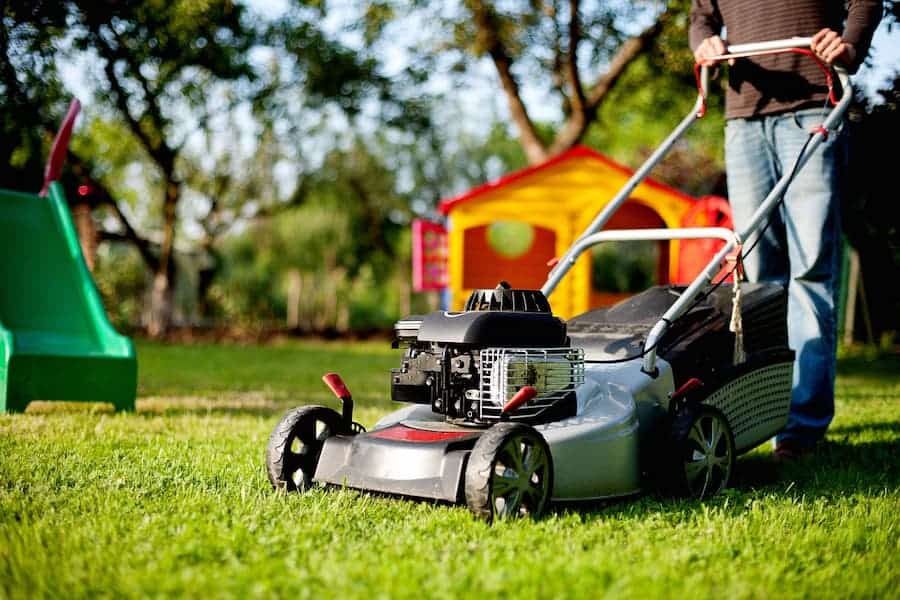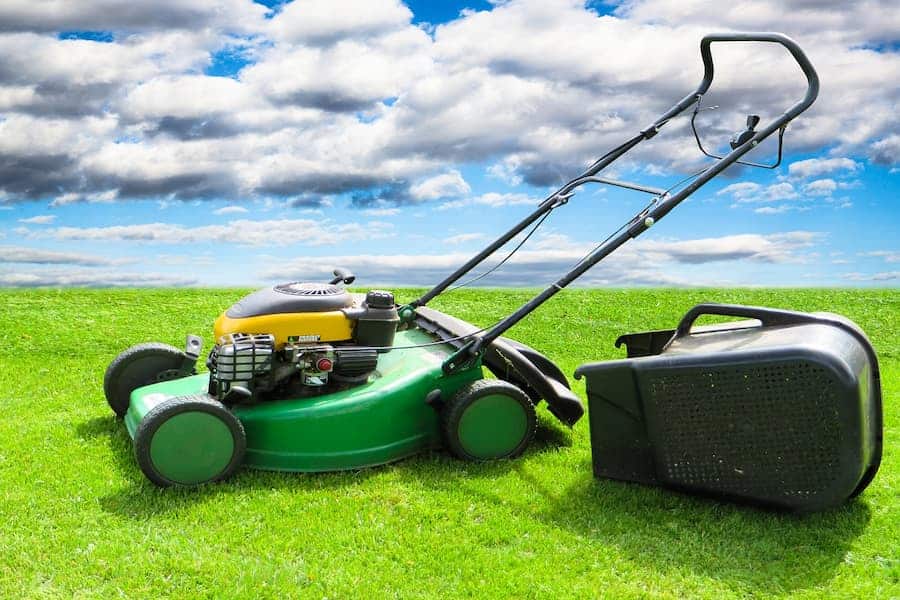There are two potential things that can go wrong with a lawn mower’s self-propulsion system. Either it stops working, or the machine becomes stuck in propulsion mode. Whichever problem you’re facing, we’ll address the possible reasons behind the difficulty and propose some potential fixes.
How to Fix A Self Propelled Lawn Mower
Whether your lawnmower is having difficulties getting in or out of gear, follow these steps to handle the problem.

- Understand how self-propelling lawn mowers work. Understanding how a lawnmower moves itself forward is the first step to figuring out what’s gone wrong with your self-propelling lawnmower and how to fix it. Read the section below to get up to speed.
- Create ideal conditions. No matter what repair you’re undertaking, the motor should be completely cool before you start to work on your lawnmower. Wear gloves to protect your hands. Drain the fuel and oil from the mower. Remove the spark plug, or disconnect the spark plug wire.
- Check the drive cable tension. The simplest fix for a self-propelled lawnmower is to adjust the drive cable tension. See below for instructions on how to do this.
- Position the lawnmower on its side. If re-tensioning the drive cable doesn’t work, you will need to check underneath the mower. It is very important that you position it correctly, to avoid spilling fuel and oil in the engine.
One side of your lawnmower contains the air filter and carburetor, while the other side houses the exhaust/muffler. Always keep the air filter/carburetor side facing upwards.
- Check the drive belt. Without a drive belt connecting the driveshaft pulley to the transmission pulley, your mower won’t go. Luckily, replacing a drive belt is relatively simple and inexpensive. See the instructions below.
- Check the gearbox. Leave this step for last, since it requires you to remove a section of the mower. Use the instructions below to check the connection between the drive cable and the gearbox, and to install a new cable if necessary.
- Accept that a fix might not make sense. Drive cable or drive belt issues are usually cost-effective to fix. If the problem is in the gearbox/transmission of your lawnmower, it may make more financial sense to purchase a new mower.
How Do Self-Propelled Lawn Mowers Work?
When your self-propelling lawnmower is working properly, squeezing the drive handle pulls on a cable. This cable, which is called the drive cable, runs down the handle of your lawnmower and ultimately connects to the transmission.
The transmission receives the message that it’s time to get in gear. A pulley on the transmission is connected to the driveshaft pulley by the drive belt, transferring power to the motor and allowing the self-propulsion feature to pull the mower forward.
A problem with your transmission may cause your mower to become stuck in self-propel mode.
There are also a number of reasons your lawn mower might stop self-propelling.

Reasons a Lawn Mower Stops Self-Propelling
There are three critical parts of the self-propulsion equation: the drive cable, the drive belt, and the transmission or gearbox. A problem with any one of them can interfere with your mower’s ability to self-propel.
Learn what to do when your lawn mower runs for a few seconds and then dies?
Snapped Drive Belt
The drive belt runs along the top of the lawnmower, stretching from the back of the mower to the center, just above the blade. It is usually black If you’ve recently attempted to cut very tall grass with the mower, the drive belt is likely to have snapped. There may even be pieces of it in your grass collection.
You can fix a snapped drive belt by purchasing and installing a replacement belt or paying a small engine shop to do it for you. Lawnmower drive belts can be purchased at most large gardening centers.
How to Replace a Drive Belt
The drive belt is an essential component of a self-propelling mower that needs to be replaced from time to time.
- Get ready. Disconnect the spark plug. Remove the fuel and oil and position the lawnmower appropriately. Put on gloves.
- Remove the blade. Undo the retaining bolt that holds the blade in place and remove the lawnmower blade.
- Locate the drive belt and undo the belt guard. The black drive belt likely has a guard around it to protect it from damage or interference. Use a screwdriver to remove the belt guard. Remove any pieces of the old belt.
- Install the new belt. One end of the belt goes on the driveshaft pulley. The other goes on the transmission pulley. Hook the belt over both pulleys. Make sure to pull the belt tight.
- Replace the belt guard. Reinsert the screws that hold the belt guard in place.
- Replace the blade. Use a wrench to tighten the retaining bolt to ensure the blade is well-secured. If you’ll be mowing tall grass, pick the correct mower blade.
Drive Cable Issues
If the cable that connects the transmission to the drive handle is broken, disconnected from the transmission, or improperly tensioned, your self-propelling lawnmower never gets the message to slip into gear. Inspect the drive cable along its lengths to rule out these common issues.

Drive Cable Not Tensioned Correctly
An improperly tensioned drive cable will feel squishy or spongy when you try to pull the handle. The cable should be fairly tense, and you shouldn’t be able to pull it more than five or ten millimeters away from the handle and rails of the lawnmower.
How to Tension the Drive Cable on a Self-Propelling Lawn Mower
Fixing the tension on the drive cable is the fastest and easiest adjustment to make to a self-propelling lawn mower that’s stopped working.
- Locate the barrel adjuster. About halfway between the handle and the mower housing, there should be a twistable barrel adjuster on the cable, held in place by a locking nut.
- Loosen the locking nut. Use an appropriate wrench to loosen the nut that locks the barrel adjuster in place.
- Twist the barrel adjuster. Tighten or loosen the cable as necessary by spinning the barrel adjuster. Stop when there are about five to ten millimeters of play in the cable, meaning it can be pulled slightly only slightly off-center.
- Relock the nut. Use an appropriate wrench to tighten the locking nut, holding the barrel adjuster in place in its new position.
Broken Drive Cable/Drive Cable Not Connected to Gearbox
If there is no tension when you squeeze the drive handle, it is likely that the drive cable is not connecting the handle to the gearbox. The cable could be broken, or it could have come loose from the gearbox.
Inspect the exposed part of the cable for breaks or damage. If you don’t find any, you will need to move on to inspecting the cable where it connects to the gearbox.
How to Check Drive Cable/Gearbox Connection
Check that the drive cable is connected to the gearbox using these instructions.
- Prepare to work on the mower. Follow the steps outlined above to prepare yourself and the mower for maintenance.
- Remove the drive cover. Use a screwdriver to remove the screw that holds the drive cover in place.
- Inspect the drive cable. The drive cable should be connected to the transmission at the anchor post. Two release tabs hold it in place. If the wire has become disconnected, reattach the cable to the anchor post and push the drive cable sheath into the transmission lever.
- If the cable has broken, remove the broken ends from the gearbox. Attach a replacement cable, routing it up the rails of the lawnmower to the drive handle.
- Reinstall the drive cover. Replace the drive cover and reinsert the screw that holds it in place.
Learn how to start a riding lawnmower with just a screwdriver.
Malfunctioning Gearbox
When you’ve ruled out issues with the drive belt or drive cable, all that’s left is a problem with the transmission. Lawnmower transmissions are not generally replaceable, so you’ll likely have to invest in a new machine. If the transmission is replaceable, the cost of labor to remove the old transmission and install a new one will likely be higher than replacing your self-propelling lawnmower.
Lawn Mower Won’t Stop Self-Propelling
At the opposite end of the spectrum, sometimes self-propelling lawnmowers get stuck in gear.
A lawnmower that won’t idle indicates a problem with the gearbox.
As mentioned above, gearboxes are not generally considered replaceable, so it’s probably time for a new mower.
If its time to grab a new mower, take a look at our budget lawn mower reviews.
Conclusion
Problems with the drive cable, belt, or transmission can cause a self-propelling lawnmower to stop working, or to get stuck in gear. Diagnose the problem and replace the affected part, if possible. If the problem is in the gearbox, you may have to replace the entire lawnmower.